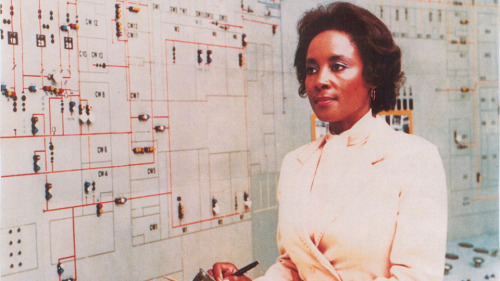
We would like to recognize the many accomplishments of noted computer scientist, mathematician and rocket scientist, Annie J. Easley.
After graduating from high school, Ms. Annie J. Easley began her career in 1955 as a “human computer” for NASA’s predecessor, the National Advisory Committee for Aeronautics (NACA). At a time when machine calculation was limited to key-punched cards manually fed into enormous machines capable only of multiplication, addition, subtraction, and division, Ms. Easley was part of a team responsible for calculating (by hand, mind you) the complex mathematical functions needed by scientists (like logarithms, exponentials, and square roots).
While still employed by the NACA, Ms. Easley earned a Bachelor of Science in Mathematics from Cleveland State University in 1977. She also participated in continuing education and specialization programs specifically sponsored by the National Atmospheric and Space Administration (NASA).
During her 34 year career with NACA (and later, NASA), Ms. Easley is credited as being one of the first #African American women in the field of rocket science, mathematics, and computer sciences. She helped develop the software for the Centaur Rocket — a high-energy rocket that came to be known as ‘America’s Workhorse in Space”. She developed and implemented computer code that analyzed alternative power technologies for electric vehicles. She also studied technologies for wind and solar energies, as well as solving problems of energy monitoring and conservation. Some of Easley’s work helped lead the way to the development of batteries for modern Hybrid cars.
Easley’s work on the Centaur project helped develop the technological foundations for space shuttle launches, as well as launches of communication, military and weather satellites. Her work contributed to the 1997 flight to Saturn of the Cassini probe, which was launched by the Centaur.
Annie’s work helped make modern-day space flight possible — and for this, we salute her.

THE AFRICAN AMERICAN WOMEN MATHEMATICIANS WHO HELPED NASA AND THE UNITED STATES WIN THE SPACE RACE: AN UNTOLD STORY (WILLIAM MORROW/HARPERCOLLINS-COMING SEPTEMBER 2016)
Hidden Figures has been optioned for the big screen! Coming Winter 2017
You've heard the names John Glenn, Alan Shepard and Neil Armstrong. What about Katherine Johnson, Mary Jackson, Dorothy Vaughan, Kathryn Peddrew, Sue Wilder, Eunice Smith or Barbara Holley?
Most Americans have no idea that from the 1940s through the 1960s, a cadre of African-American women formed part of the country’s space work force, or that this group—mathematical ground troops in the Cold War—helped provide NASA with the raw computing power it needed to dominate the heavens. My current work in progress, a narrative non-fiction book entitled HIDDEN FIGURES recovers the history of these pioneering women and situates it in the intersection of the defining movements of the American century: the Cold War, the Space Race, the Civil Rights movement and the quest for gender equality.
We all know what a scientist looks like: a wild-eyed person in a white lab coat and utilitarian eyeglasses, wearing a pocket protector and holding a test tube. Mostly male. Usually white. Even Google, our hive mind, confirms the prevailing view. Just do an image search for the word “scientist”.
For me, growing up in Hampton, Virginia, the face of science was brown like mine. My dad was a NASA lifer, a career Langley Research Center scientist who became an internationally respected climate expert. Five of my father’s seven siblings were engineers or technologists. My father’s best friend was an aeronautical engineer. Our next door neighbor was a physics professor. There were mathematicians at our church, sonic boom experts in my mother’s sorority and electrical engineers in my parents’ college alumni associations. There were also black English professors, like my mother, as well as black doctors and dentists, black mechanics, janitors and contractors, black shoe repair owners, wedding planners, real estate agents and undertakers, the occasional black lawyer and a handful of black Mary Kay salespeople. As a child, however, I knew so many African-Americans working in science, math and engineering that I thought that’s just what black folks did.
Dr. Christine Darden. Courtesy NASA
After the start of World War II, Federal agencies and defense contractors across the country coped with a shortage of male number crunchers by hiring women with math skills. America’s aeronautical think tank, the National Advisory Committee for Aeronautics (the “NACA”), headquartered at Langley Research Laboratory in Hampton, Virginia, created a pool of female mathematicians who analyzed endless arrays of data from wind tunnel tests of airplane prototypes. Women were thought to be more detail-oriented, their smaller hands better suited for repetitive tasks on the Friden manual adding machines. A “girl” could be paid significantly less than a man for doing the same job. And male engineers, once freed from laborious math work, could focus on more “serious” conceptual and analytical projects.
The war also opened doors for African-Americans. In 1941, under pressure from labor and civil rights leaders such as A. Phillip Randolph, President Franklin Roosevelt signed Executive Order 8802, which created the Fair Employment Practices Committee, and prohibited race-based discrimination in the country’s defense industry. Shortly thereafter, help wanted notices began appearing in Negro newspapers around the country, looking for blacks to fill positions at Federal agencies and defense contractors. Langley advertised in Norfolk, VA’s Journal and Guide, seeking machine shop workers, laborers, janitors—and African-American women with math degrees.
These women were nearly all top graduates of historically black colleges such as Hampton Institute, Virginia State and Wilberforce University. Though they did the same work as the white women hired at the time, they were cloistered away in their own segregated office in the West Area of the Langley campus-- thus the moniker, the West Computers. But despite the hardships of working under Virginia's Jim Crow laws, these women went on to make significant contributions to aeronautics, astronautics, and America's victory over the Soviet Union in the Space Race.

No comments:
Post a Comment